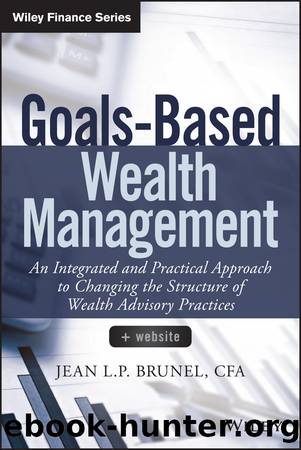Goals-Based Wealth Management + Website by Jean L. P. Brunel

Author:Jean L. P. Brunel [Brunel, Jean L. P.]
Language: eng
Format: epub
ISBN: 9781118995938
Published: 2015-03-23T00:00:00+00:00
Figure 9.1 Illustrating the Difference Between Median and Probability-Based Discount Rate
Certain people initially objected to this formulation of the discount rate, as, by definition, the return that we use will be met or exceeded. Thus, it is likely that the sum of money that is set aside will turn out to be more than actually needed. Yet, the objection quickly crumbles in the face of the behavioral finance principles we discussed in Chapter 5: individuals are worried about shortfall,2 not about exceeding their goals.3 The real challenge would be to under-budget for a goal rather than to budget too much. Anticipating an issue we will discuss later, this leaves us some room to revisit certain decisionsâin terms of sizing the assets needed to meet a goalâfor those clients whose total assets appear insufficient to meet all goals. At times, simply cutting the required probability of success from 95 percent to 85 percent might suffice to go from an asset deficit to some small surplus. Is it truly crucial for you, dear client, that this goal be viewed as a need that must be met versus a want that should be met?
In general, one can formulate two simple rules to help one understand the dynamic of time horizons and required probabilities of success. First, it stands to reason that the longer the time horizon, the more risk can be taken at any given level of required probability of success. Although short-term volatility of returns would be higher, time would help smooth that volatility out. Second, it is also clear that, for any given time horizon, the higher the required probability of success, the lower the investment risks that can be taken. Except for advisors whose firms have chosen to have âlabel-basedâ goals-based modules, the challenge when deciding which module to choose for which goal revolves around looking for the module that produces the highest expected return at a given time horizon with a set required probability of success4.
Tables 9.1 and 9.2 illustrate this issue and help make the simple point that settling on the appropriate module does not have to be terribly complicated. Table 9.1 requires some initial explanation. It shows the maximum return available across all modules over the given time horizon and at some given level of required probability. These data are obtained by applying to all modules the process that is illustrated in Figure 9.1. As return distributions are assumed to be normal, we can calculate what the return is that will be met or exceeded, over each of the various time horizons, with each of the required given probabilities of success.5 The data in each of the cells of Table 9.1 represents the maximum return available across all modules for each given probability of success6 and over the relevant time horizon. The only exception to this rule is an arbitrary decision we make to force the return7 of the lowest risk module into the table, for the 90 percent and 95 percent probability levels and the five-year time horizon.
Download
This site does not store any files on its server. We only index and link to content provided by other sites. Please contact the content providers to delete copyright contents if any and email us, we'll remove relevant links or contents immediately.
Storytelling for dummies by Andrea Fontana(1492)
Effortless by Greg McKeown(1433)
The Practice by Seth Godin(1403)
Mastering Blockchain by Lorne Lantz(1392)
Blockchain Quick Reference by Paul Valencourt & Samanyu Chopra & Brenn Hill(1149)
Mastering Blockchain by Lorne Lantz & Daniel Cawrey(909)
The wind in the willows by Kenneth Grahame(848)
How to Lead by David M. Rubenstein(823)
The Ape in the Corner Office by Richard Conniff(789)
Social Media Engagement For Dummies by Aliza Sherman(710)
Handbook of Big Data Analytics by Unknown(710)
Taking Care of Yourself (HBR Working Parents Series) by Harvard Business Review(696)
Getting Started with Data: The first book you should read to successfully get along with data. by Menegatti Gabriel & Team Simbiose Ventures(693)
FunRetrospectives: activities and ideas for making agile retrospectives more engaging by Paulo Caroli & Tainã Caetano Coimbra(691)
Business Storytelling For Dummies by Unknown(670)
Evernote for Self Publishing: How to Write Your Book in Evernote from Start to Finish by Jose John(667)
Help! My Facebook Ads Suck-- by M. D. Cooper & Jill Cooper(652)
A Leader Listens by Ajay Banga(639)
Genius by Choice: Your unconventional A–Z handbook to enhance your learning process by Remondino Giulia S(638)
